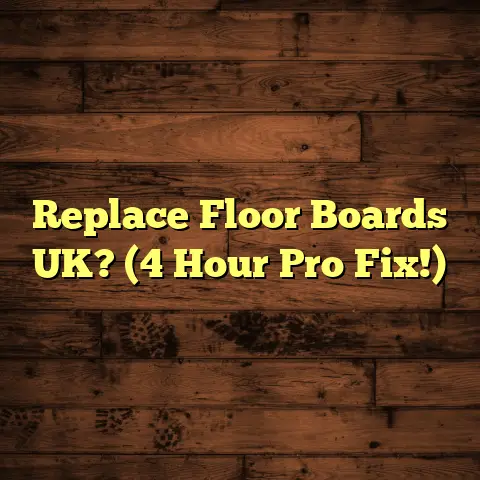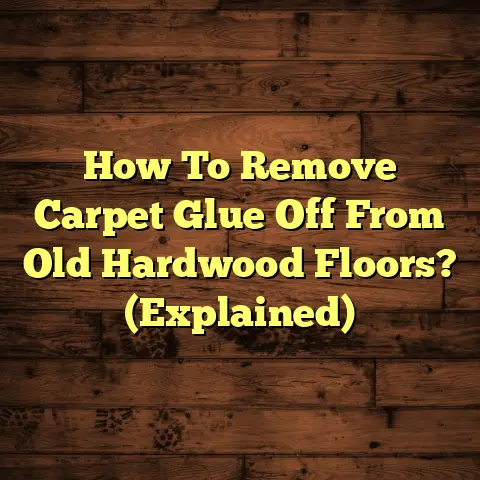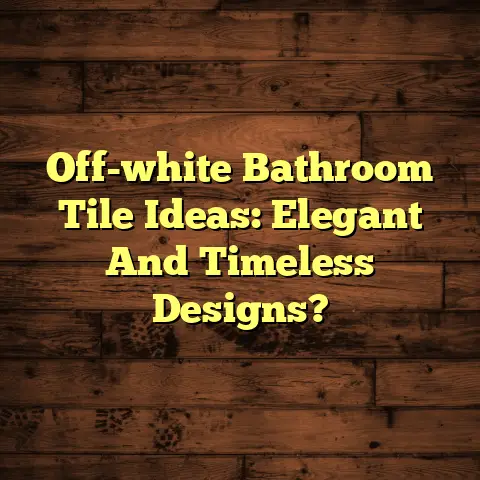Key Factors Influencing Carpet Pricing? (Explained)
When I start a flooring project, one of the first topics that comes up with clients is budget options. Carpets can range from budget-friendly to high-end luxury, and understanding what influences these price variations can help us make informed decisions.
As I’ve navigated through various projects, I’ve learned that several key factors play significant roles in determining carpet pricing. Let me share my insights, experiences, and some practical advice to help you understand how to approach your next carpet installation.
Quality of Materials
The quality of materials is perhaps the most influential factor in carpet pricing.
High-quality carpets are often made from natural fibers like wool or silk. Wool carpets, for instance, can cost anywhere from $8 to $20 per square foot. The durability and comfort of wool are hard to beat, but the investment is higher.
On the other hand, synthetic fibers like nylon or polyester offer a wider range of pricing. Nylon is known for its resilience and can cost between $3 to $10 per square foot, while polyester tends to be cheaper, usually around $2 to $5 per square foot.
In my experience, choosing the right material depends on the room and its use. For example, I once installed a nylon carpet in a high-traffic family room. The durability proved invaluable as it withstood years of wear and tear while remaining easy to clean.
Carpet Style and Construction
The style and construction of the carpet also affect its price. Carpets come in various styles such as plush, Berber, and frieze. Each has its own unique construction method which can influence the cost.
For instance, a plush carpet has a soft texture but is not as durable in high-traffic areas. It typically ranges from $3 to $12 per square foot. In contrast, Berber carpets are looped and often more resilient, making them suitable for busy households. They can range from $4 to $10 per square foot.
During a recent project, I encountered a client who wanted a plush carpet for their living room. After discussing the wear it would experience, we opted for a Berber style instead, which offered both comfort and durability without breaking the bank.
Brand Reputation
Brand reputation plays a role as well. Established brands often charge more due to their proven quality and warranties. For example, you might find a well-known brand selling carpets for $5 to $15 per square foot, while lesser-known brands could offer similar styles for $2 to $8.
I’ve found that clients appreciate hearing about the brands I trust based on my experiences. When I installed a high-end carpet from a reputable brand for a commercial client, the quality was evident in the longevity and low maintenance costs.
Carpet Padding
Don’t overlook the importance of carpet padding when budgeting for installation. Good padding enhances comfort, prolongs carpet life, and is critical for sound insulation.
Padding can range from $0.50 to $2 per square foot depending on thickness and material. I remember one instance where I skimped on padding to save costs. A few months later, the client was dissatisfied with how the carpet felt underfoot. We had to redo the installation with better padding at additional expense.
Installation Costs
Installation costs can vary widely based on location and complexity. Typical installation rates range from $1 to $5 per square foot. If you’re installing a carpet in a simple rectangular room, costs will be at the lower end. However, if you’re dealing with stairs or intricate layouts, expect higher rates.
Using FloorTally has been instrumental for me in estimating project costs accurately. It aggregates local labor rates and material costs, allowing me to present realistic budgets upfront. This feature has been a game changer in managing client expectations.
Geographic Location
Your geographic location influences both material and installation costs. Urban areas may have higher prices due to demand and cost of living compared to rural regions.
For example, I worked on a project in New York City where carpet prices were significantly higher than in my hometown in rural Illinois. The same quality material could cost me $10 per square foot in NYC but only $5 in Illinois.
Seasonal Trends
Seasonal trends can also impact pricing. I’ve noticed that certain times of the year see an influx of sales and promotions, especially during spring and fall. If you’re flexible with timing, you could save significantly.
I recall a project where I planned an installation during a seasonal sale. It resulted in savings of nearly 20% on materials alone, which I gladly passed on to my client.
Additional Features
Many carpets come with additional features like stain resistance or eco-friendly certifications, which can also increase costs. Stain-resistant carpets can be beneficial in homes with children or pets, typically adding about $1 per square foot.
In one project, my clients opted for an eco-friendly carpet made from recycled materials. While it was pricier upfront, they appreciated the long-term benefits and sustainability aspect.
Maintenance and Lifespan
Maintenance requirements can affect overall costs too. Higher-end carpets often require professional cleaning every 12-18 months, while lower-end options may need it less frequently.
For instance, I installed a beautiful wool carpet that required special care. The clients were committed to maintenance but had to adjust their budget for periodic professional cleaning services.
Environmental Considerations
Sustainability has become increasingly important in our industry. Eco-friendly carpets made from recycled materials or produced with less environmental impact can be more expensive initially but may save money over time through durability and lower maintenance needs.
I once had a conversation with a client who was passionate about sustainability. They chose a carpet made from recycled plastic bottles despite its higher cost because they valued reducing their carbon footprint.
Customization Options
Customization is another factor that can influence carpet pricing. Custom patterns or colors often come at a premium due to the additional manufacturing processes involved.
In one project, a client wanted a unique pattern for their office space. The custom design added about 30% to the total cost but ultimately created an inviting atmosphere that impressed both employees and clients.
Color Choices
Color can also impact pricing due to popularity or availability. Neutral colors tend to be more common and may be less expensive than trendy or bold colors that require special dyeing processes.
For instance, during one installation project, my client insisted on a vibrant blue carpet that was less available than standard beige options. The cost was substantially higher due to its rarity and dyeing methods needed to achieve the desired shade.
Warranty and Guarantees
Warranties are essential when considering carpet investments. Higher-priced carpets often come with extensive warranties that cover wear and tear or stains, providing peace of mind.
In my experience, clients appreciate knowing they are protected should issues arise down the line. I recall a situation where we installed a high-end carpet with a 20-year warranty; it gave both me and my client confidence in the investment.
Cost Comparison of Different Carpet Types
Let’s break down some comparative costs of different types of carpets to provide clarity:
| Type | Price per Square Foot | Durability | Maintenance Frequency |
|---|---|---|---|
| Wool | $8 – $20 | High | Every 12 months |
| Nylon | $3 – $10 | Medium-High | Every 12-18 months |
| Polyester | $2 – $5 | Medium | Every 18-24 months |
| Berber | $4 – $10 | High | Every 12-18 months |
| Frieze | $3 – $12 | Medium | Every 12-18 months |
This table summarizes some key differences that might help guide your decision-making process.
Personal Anecdotes: Successes and Challenges
Through my years in flooring contracting, I’ve had my fair share of successes and challenges that have shaped my understanding of carpet pricing.
Success Story: A Happy Client
I once worked on a project for a family who wanted new carpeting throughout their home. They were initially worried about staying within budget while achieving their desired look. After discussing various options, we settled on a durable nylon carpet that fit their budget perfectly at around $5 per square foot.
The installation went smoothly, thanks to careful planning using FloorTally for accurate cost estimation and scheduling. The clients were thrilled with the result and even referred me to their friends afterward!
Challenge: Unexpected Costs
Conversely, there have been projects where unexpected costs arose due to hidden factors like outdated flooring removal or uneven subflooring issues. In one case, I underestimated the time needed for preparing an older home’s subfloor before installing new carpeting.
After realizing the additional work required, I had to communicate this to my client transparently. We ended up adjusting the budget slightly but ultimately delivered an excellent result that satisfied everyone involved.
Practical Tips for Choosing Carpet
Here are some actionable tips based on my experiences that can help you make more informed decisions:
- Set a Realistic Budget: Determine how much you can spend upfront, including materials and installation.
- Choose Quality Over Cost: Investing in higher-quality materials may save money over time through durability and lower maintenance needs.
- Don’t Skimp on Padding: Good padding enhances comfort and prolongs carpet life—don’t overlook this aspect of your budget!
- Consider Traffic Patterns: Evaluate how much foot traffic each area will experience when selecting your carpet style and material.
- Research Brands: Look into reputable brands known for quality; they might offer better warranties and longevity.
- Plan for Maintenance: Factor in cleaning costs when budgeting—some carpets require more frequent professional cleaning than others.
- Be Open to Seasonal Sales: Timing your purchase around sales events can lead to significant savings.
- Explore Eco-Friendly Options: If sustainability is important to you, look into eco-friendly carpets which might come at a premium initially but offer long-term benefits.
- Consult with Professionals: Don’t hesitate to ask for advice from flooring contractors; they often have insights based on real-world experience.
- Keep Color Trends in Mind: While trendy colors may appeal now, consider how they’ll hold up over time—neutral colors might offer more longevity in terms of style.
Installation Process: What to Expect
Let’s talk about what you can expect during the installation process itself:
- Preparation: Before installation day, ensure that your space is cleared of furniture and other items.
- Measuring: Accurate measurements will be taken to ensure proper fitting of carpets.
- Subfloor Inspection: Inspecting the subfloor condition is crucial; any issues must be addressed before laying down new carpeting.
- Padding Installation: Quality padding will be laid out first; this step is essential for comfort and longevity.
- Carpet Laying: The carpet will be rolled out over the padding, cut appropriately around edges, and secured.
- Finishing Touches: After installation, any seams will be blended in for a seamless look; trimming excess material will also occur.
- Cleanup: A thorough cleanup will follow—there’s nothing worse than leaving behind debris!
By understanding what goes into an installation process like this one, you’ll feel more prepared and informed as you move forward with your project.
Concluding Thoughts on Carpet Pricing
Understanding these key factors influencing carpet pricing can help you navigate your choices more effectively. From material quality to installation costs and maintenance considerations, each element contributes to the final price tag of your carpet project.
By sharing my personal experiences and insights here, I’ve aimed to provide you with practical tips you can apply to your next flooring venture. Whether you’re looking for budget options or considering high-end alternatives, knowing these factors will empower you to make informed decisions that suit your needs and preferences.
Remember to consider your lifestyle when choosing your carpet; if you have pets or children, prioritize durability over aesthetics. And don’t forget about padding—it’s worth investing in good quality for comfort and longevity.
Ultimately, every project is unique, and I’ve learned that flexibility often leads to better outcomes. Happy carpeting!





